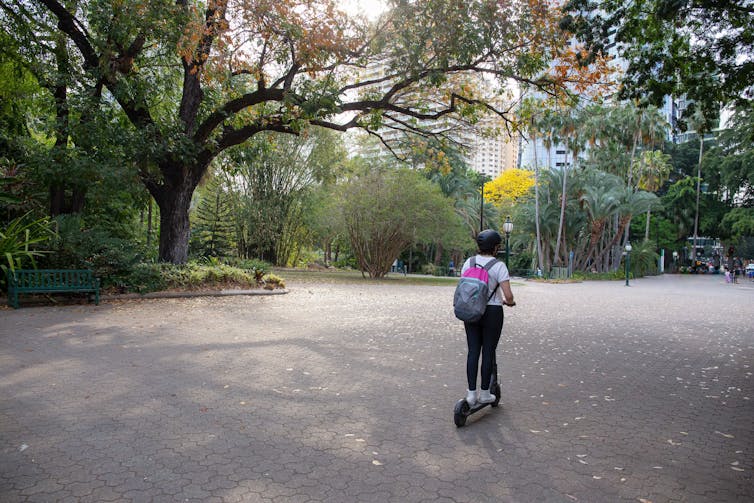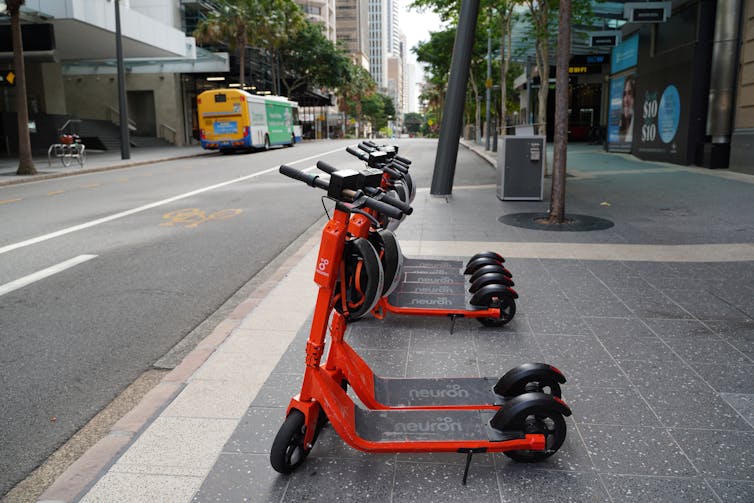Five years after introducing rideshare electric scooters for the first time in Australia, Brisbane is leading the way, with many growing pains and a lot of learning.
Our latest research investigated tourists' and residents' perceptions and experiences of the city. We conducted a first-of-its-kind survey of both users and non-users of electric scooters and bicycles. Nearly 1,000 responses were received and 29 follow-up interviews were conducted.
Cities around the world are incorporating micromobility, such as electric scooters and e-bikes, as part of their transportation plans. They promote active transportation such as walking and cycling, reduce car travel and traffic congestion, reduce greenhouse gas emissions, improve city-wide accessibility, and promote the overall well-being of residents. , you want to enjoy the widely proven benefits.
Still, micromobility remains a subject of social debate. With more tourists using shared bikes and scooters, and some cities banning them, an important issue is being overlooked. How do these devices shape the visitor experience and the image of the city? How do residents think about their use? And what do non-users think?
Well, I understand. In Brisbane, these new modes of transport are increasingly viewed as positive alternatives to private cars, public transport and rider-share services. Compared to the days when cars replaced horses, micromobility options offer a convenient and improved travel experience that showcases the best parts of a city.
Read more: Limes, not lemons: Lessons from Australia's first electric scooter sharing trial
Micromobility services are good for a city's image
When tourists arrive in a new city, they face common challenges: where to go, what to see, and more importantly, how to get there.
Public transport is considered too stressful, confusing and sometimes unpleasant. Carpools and taxis are easy and familiar, but they lack the experience and leave you missing out on every nook and cranny of your destination.
A clear majority of visitors who took part in our survey (83% users, 42% non-users) agreed that electric scooters and electric bikes improve their tourist experience and the way they see the city. Because these modes of transportation have vastly increased the number of places we can see and experience. As a result, they viewed Brisbane as a vibrant, modern city.
For many, riding an electric e-scooter was one of the best parts of visiting the city. One tourist told us:
If you have the opportunity to use an electric scooter during your visit to Brisbane, you'll be able to enjoy the beautiful surroundings that you wouldn't normally get from a taxi or Uber.

shutter stock
Read more: E-scooters are becoming very popular – but you need to consider the weather
Another tourist said:
I'm really glad I tried it [an e-scooter]. In fact, it was the highlight of our trip.
Common reasons for such positive opinions include accessibility, convenience, sustainability, independence, novelty, spontaneity, maintaining a healthy lifestyle, getting out, feeling of community, and ease of use. included.
Similarly, non-user visitors primarily see electric scooters as a benefit to the city. They consider them good for their image, or indifferent but attractive to others.
One tourist who is not an electric scooter user said:
I don't think there are any bad images so far. On the contrary, I feel that it gives an image of providing an alternative to cars.
Brisbane's robust cycling infrastructure, dubbed the 'Scooter Highway' by study participants, was a contributing factor to these positive opinions for all groups.
Another tourist who was not a user said the following.
Most people generally feel responsible about riding their bikes and not in the middle of the sidewalk. I think it's definitely a good resource.

shutter stock
Read more: The urban bike share equation changes as one in three users becomes a tourist
How do the opinions of tourist and resident riders differ?
We asked both tourists and residents for their opinions. All groups primarily viewed e-scooters and e-bikes as an alternative rather than an adjunct to public transport. A small number of people used electric scooters in combination with public transport.
Brisbane visitors who were not familiar with public transport found the micromobility option very convenient. They can now explore more attractions faster using electric scooters and e-bikes without the hassle of buying travel cards or checking public transport timetables. I did.
For visitors, micromobility itself is a tourist experience comparable to traditional tourist attractions such as shopping and landmarks. For residents, it's a convenient, independent, reliable and efficient way to commute, run errands, or go out to dinner with friends.
Read more: Wallets on wheels: City visitors who use electric scooters spend more money
What about non-users?
Differences between users and non-users were found. Users have overwhelmingly positive opinions (74%) about the benefits for themselves and others. Non-users either perceive benefits to others or are skeptical and concerned about safety.
However, most non-users (65%) still view shared electric scooters and e-bikes as public resources. Only a minority (35%) considered them a nuisance.
So what's stopping more people from using them? Commonly cited barriers include:
- safety concerns
- I don't know how to ride
- expensive
- Self-image – I don’t see myself as an electric scooter/e-bike rider
- Some areas lack infrastructure suitable for cycling.
- Hygiene concerns after COVID-19
Read more: Want to avoid high fuel prices with an electric scooter or e-bike? Answers to 5 important questions
Micromobility is becoming popular
Our findings are clear. Micromobility is a win for urban transport and tourism. Visitors and residents who are able and willing to use electric scooters and electric bikes now have a better way to get around the city and experience all that the city has to offer. Users have very positive views about these modes of transport and their impact on the city as a whole.
Efforts to improve safety and access by lowering individual barriers have the potential to improve perceptions of micromobility and cities. Further innovation in electric scooter design, supported by educational campaigns, complementary infrastructure and policies, could lead to greater uptake and more positive opinions.

